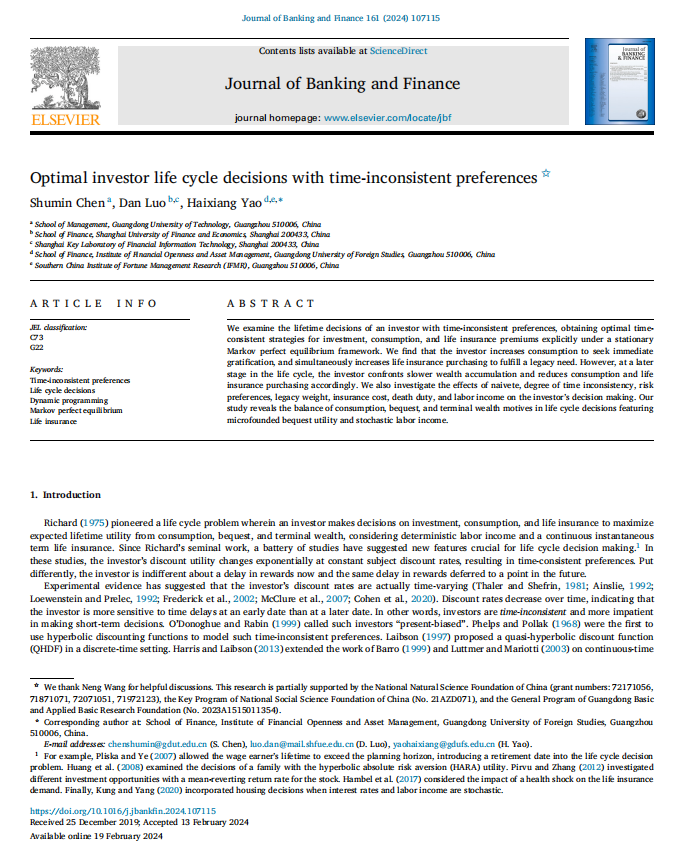近日,公司姚海祥教授(通讯作者)与合作者的论文Optimal investor life cycle decisions with time-inconsistent preferences(时间不一致偏好下投资者的最优生命周期决策)在金融学科国际一流期刊Journal of Banking and Finance(简称JBF)上发表。
作者简介
姚海祥,广外教授(三级)、博士生导师、云山杰出学者、广东省青年珠江学者(设岗学科为金融学),广州市金融高级专业人才。曾任betway体育副经理。目前主要从事机器学习与量化投资、养老风险管理和系统性风险管理等方面的研究工作,近年来已在Journal of Banking and Finance, International Review of Financial Analysis 、Journal of Empirical Finance、 Pacific-Basin Finance Journal、Journal of Economic Dynamics & Control、European Journal of Operational Research 、Journal of Forecasting、Quantitative Finance、Insurance: Mathematics and Economics、ASTIN Bulletin、Computers & Operations Research、Expert Systems With Applications 、Economic Modelling、Journal of the Operational Research Society、《管理科学学报》、《中国管理科学》、《系统工程理论与实践》、《财经研究》和《数理统计与管理》等国内外重要期刊上发表学术论文近80篇(绝大多数为第一作者),其中40余篇被SSCI/SCI检索。近年来,主持了国家社科基金重点项目(重大转重点),国家自然科学基金面上项目(3项)、中国博士后科学基金特别资助项目和一等资助面上项目、教育部人文社科基金项目和广东省自然科学基金重点项目等20多项项目。他所带领的“投资管理、期权定价和风险管理”科研团队入选为广东普通高等学校创新团队。主要学术兼职包括:《运筹与管理》(CSSCI和CSCD来源期刊)编委;中国管理科学与工程学会金融计量与风险管理研究会理事、常务理事;中国优选法统筹法与经济数学研究会量化金融与保险分会常务理事;中国管理现代化研究会金融管理专业委员会理事等。

[1]Shumin Chen, Dan Luo, Haixiang Yao*. Optimal investor life cycle decisions with time-inconsistent preferences(时间不一致偏好下投资者的最优生命周期决策). Journal of Banking and Finance, 2024, 161: 107115.
论文简介:
我们研究了具有时间不一致偏好的投资者在生命周期内的投资、消费和寿险决策问题,并在平稳马尔可夫完美均衡框架下获得了投资、消费和人寿保险费最优时间一致策略的显式表达式。我们发现,投资者为了寻求即时满足而增加消费,同时增加购买人寿保险以满足遗赠需求。然而,在生命周期的后期,投资者面临着财富积累放缓的问题,并相应地会减少消费和人寿保险购买。我们还探讨了天真、时间不一致程度、风险偏好、遗产权重、保险成本、遗产税和劳动收入等因素对投资者决策的影响。我们的研究揭示了生命周期决策中考虑了遗赠效用微观基础和随机劳动收入下的消费、遗赠和最终财富动机的平衡。
原文摘要:
We examine the lifetime decisions of an investor with time-inconsistent preferences, obtaining optimal time-consistent strategies for investment, consumption, and life insurance premiums explicitly under a stationary Markov perfect equilibrium framework. We find that the investor increases consumption to seek immediate gratification, and simultaneously increases life insurance purchasing to fulfill a legacy need. However, at a later stage in the life cycle, the investor confronts slower wealth accumulation and reduces consumption and life insurance purchasing accordingly. We also investigate the effects of naivete, degree of time inconsistency, risk preferences, legacy weight, insurance cost, death duty, and labor income on the investor’s decision making. Our study reveals the balance of consumption, bequest, and terminal wealth motives in life cycle decisions featuring microfounded bequest utility and stochastic labor income.
